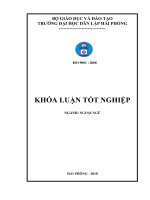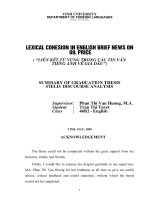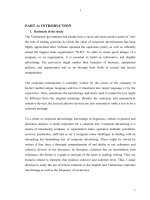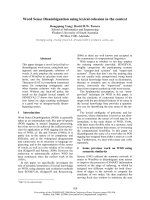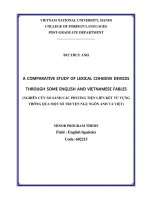Lexical cohesion in english brief news on oil price = liên kết từ vựng trong các tin vắn tiéng anh về giá dầu
Bạn đang xem bản rút gọn của tài liệu. Xem và tải ngay bản đầy đủ của tài liệu tại đây (324.49 KB, 51 trang )
Vinh university
Department of foreign languages
=== ===
Lexical cohesion in English brief news on
oil price
( “liªn kÕt tõ vùng trong các tin vắn
tiếng anh về giá dầu)
summary of Graduation thesis
Field: Discourse analysis
Supervisor:
Student :
Class
:
Phan Thi Van Huong, M.A.
Tran Thi Tuyet
46B2 - English
Vinh, May- 2009
Acknowledgement
The thesis could not be completed without the great support from my
lecturers, family and friends.
Firstly, I would like to express my deepest gratitude to my supervisor,
MA. Phan Thi Van Huong for her readiness at all time to give me useful
advice, critical feedback and useful materials, without which the thesis
would not be completed.
1
Secondly, I should like to thank all my lecturers from Department of
Foreign Languages, Vinh University for their valuable lectures on the area
which help me orient the topic.
Finally, I wish to thank my family and my friends for their support and
encouragement they gave me when I was doing this thesis.
i
2
TABLE OF CONTENTS (chua co so trang)
Acknowledgement
Tables of contents
Part A: Introduction
1. Reasons for Choosing the Topic
2. Aims of the Study
3. Scope of the Study
4. Methods of the Study
5. Design of the Study
Part B: Developments
Chapter 1: Theoretical Background
1.1.
Discourse
1.2.
Discourse and Text
1.3.
Spoken and Written Discourse
1.4.
Discourse Context
1.4.1. Context of Situation
1.4.2. Context versus Co- text
1.5.
The Concept of Cohesion
1.6.
Cohesion and Coherence
1.7.
Types of Cohesive Devices
1.8.
Lexical Cohesion
1.8.1. Concept of Lexical Cohesion
1.8.2. Types of Lexical Cohesion
1.8.2.1. Collocation
1.8.2.2. Reiteration
Chapter 2: Lexical Cohesion in English Brief News on Oil Price
2.1. A Brief Introduction to Data under Analysis
2.2. General Structure of Brief News in English Press
2.3. Lexical Cohesion in English Brief News on Oil Price
2.3.1. Collocation
3
2.3.2. Reiteration
2.3.2.1. Repetition
2.3.2.2. Synonyms/Near - synonyms
2.3.2.3. Superordinates and General Words
Chapter 3: Discuss and Implication
3.1. Discussion
3.2. Some Implications for Teaching and Learning English Lexical
Cohesion
3.3. Suggested Exercises
Part C: Conclusion
References
Appendix
4
TABLE OF CONTENTS
Acknowledgement
Tables of contents
Part A: Introduction
6. Reasons for Choosing the Topic
7. Aims of the Study
8. Scope of the Study
9. Methods of the Study
10. Design of the Study
Part B: Developments
Chapter 1: Theoretical Background
1.9.
Discourse
1.10. Discourse and Text
1.11. Spoken and Written Discourse
1.12. Discourse Context
1.12.1. Context of Situation
1.12.2. Context versus Co- text
1.13. The Concept of Cohesion
1.14. Cohesion and Coherence
1.15. Types of Cohesive Devices
1.16. Lexical Cohesion
1.16.1. Concept of Lexical Cohesion
1.16.2. Types of Lexical Cohesion
1.16.2.1. Collocation
1.16.2.2. Reiteration
Chapter 2: Lexical Cohesion in English Brief News on Oil Price
2.1. A Brief Introduction to Data under Analysis
2.2. General Structure of Brief News in English Press
2.3. Lexical Cohesion in English Brief News on Oil Price
2.3.1. Collocation
ii
2.3.2. Reiteration
2.3.2.1. Repetition
2.3.2.2. Synonyms/Near - synonyms
2.3.2.3. Superordinates and General Words
Chapter 3: Discuss and Implications
3.1. Discussion
3.2. Some Implications for Teaching and Learning English Lexical Cohesion
3.3. Suggested Exercises
Part C: Conclusion
References
Appendix
5
iii
Pages
i
ii
1
1
2
2
2
4
4
5
7
7
8
9
9
11
11
11
12
12
12
14
14
15
15
17
17
20
21
25
26
26
33
35
Part A:
Introduction
1. Reasons for Choosing the Topic
When reading a text, the first impression that helps readers understand
its content is the feeling that it hangs together. This way is implemented by
various linguistic devices including grammatical and lexical ones. According
to David Nunan (1995:31), lexical cohesion is the single most important
form of cohesion, accounting for something like 40% of cohesion ties in text.
Therefore, lexical cohesion can also make significant contribution to creating
coherence of discourse. The first reason originates from the author’s belief
that obtaining a sufficient awareness of the vivid existence of lexical
cohesion as a cohesive device, of its significant role in generating textual
coherence as well as of proper ways in which it is used by native speakers
(writers) can be helpful to her learning and writing English.
Authentic materials are no doubt a good source for language learning.
English brief news are said not only to contain updated information but also
6
to be a useful and typical demonstration of lexical as well as grammatical
cohesion usage.
Moreover, being interested in lexical cohesion, we find it very
interesting and appropriate to apply related theories into news-in-brief daily
updated on oil price-one of the hottest topics in the world now.
From the above-mentioned reasons, we decided to choose “Lexical
Cohesion in Brief News on Oil Price” to be the theme of the thesis.
2. Aims of the Study
The aims of the thesis are:
- To emphasize the important role of lexical cohesion in creating textual
coherence.
- To give some statistics and descriptions of lexical cohesion used in the
selected English brief news.
- To make a first attempt to study the reasons leading to different
degrees of fondness in using each type of lexical cohesion in English brief
news.
- To suggest some practical applications in teaching and learning
English lexical cohesion using English brief news as authentic material.
3. Scope of the Study
Our study deals with types of lexical cohesion in discourse provided by
Halliday & Hasan (1976) including collocation and reiteration. Types of
grammatical cohesion are out of the thesis.
The
data
analyzed
in
the
thesis
are
brief
news
in
and />The brief news are about world current oil price. The oil price in the world has
viotiled so much and has become a hot topic in the press.
Examples employed in chapter 2 are taken from the brief news.
4. Methods of the Study
7
- Collecting brief news related to the topic: world oil price.
- Finding out the examples containing different types of lexical
cohesion
- Analyzing some typical examples of each type.
- Reaching some conclusions on the subject-matter under investigation
and accordingly giving necessary comments.
5. Design of the Study
There are 3 main parts in this research paper:
Part A: Introduction
This part introduces the reasons, aims, scope, methods and design of the
study.
Part B:
Development
This part consists of three chapters:
Part C:
Chapter 1:
Theoretical background
Chapter 2:
Lexical cohesion in brief news on oil price
Chapter 3:
Discussion and Implication
Conclusion
This part reviews what has been discussed in the content of the thesis
and points out some suggestions for further study.
8
Part B: Development
Chapter 1: Theoretical Background
1.1.
Discourse
Since the time Discourse Analysis came into being as a branch of
linguistics, the term “discourse” has been defined in different ways. A
discourse, according to Crystal (1992:25) is “a continuous stretch of
(especially spoken) language larger than a sentence, often constituting a
coherent unit such as a sermon, argument, joke or narrative”. Barbara
Johnstone (2002:2) claims that “discourse usually means actual instances of
communication in the medium of language”. According to Nunan (1993), a
discourse is “a stretch of language consisting of several sentences perceived
as being related in some ways, in terms of the ideas they share and in terms
of the jobs they perform within discourse.”
In this thesis, the notion that seems to be the most acceptable is the one
proposed by Guy Cook (1995:198) seeing discourse as “stretches of
language perceived to be meaningful, unified and purposive”.
1.2.
Discourse and Text
There is still disagreement about the meaning of these two terms
“discourse” and “text”. For some linguists, the terms seem to be used almost
interchangeably as Nunan (1995:1) indicates “A text, or a discourse, is a
stretch of language that may be larger than a sentence.”
However, some other writers draw a clear distinction between them.
Widdowson (1984) is probably one of the first who make a very explicit
distinction. According to him, text typically has cohesion whereas
discourse has coherence, which can be illustrated by the following
example:
A: Did you buy meat for lunch, Lan?
B: I have not gone to market yet.
9
Although there is no formal link between A and B, the listener can infer
that Lan did not buy meat because she had not gone to market.
As in Widdowson (1984:100) the difference and the interrelationships
between the two can be summarized:
Discourse is a communicative process by means of interaction. Its
situational outcome is a change in a state of affairs: information is
conveyed, intensions made clear, its linguistic product is text.
Other acclamations of some linguists are also similar to Widdowson’s
viewpoint, i.e., discourse is language in action (or interaction) while a text is
the written record of that interaction. It is obvious that this view sees
discourse as bringing together language, the individuals producing the
language and the context within which the language is used. On the other
hand, other linguists tend to avoid using the term “discourse” altogether, and
accept the term “text” for all recorded instances of language in use.
This study supports the distinction indicated by Salkie (1993): “the term
text is used to refer to any written record of a communicative event whereas
the term discourse refers to the interpretation of the communicative event in
context”. The event itself can be oral language (a sermon, a casual
conversation, a shopping transaction) or written language (a poem, a
newspaper advertisement, a wall poster, etc.)
1.3.
Spoken and Written Discourse
Spoken and written discourse simply mean speech and writing. It has
been widely agreed by linguists that there are common features as well as
different ones between these two forms of language.
According to Halliday (1985), writing emerged in society as a result of
cultural changes which created new communicative needs that could not be
readily met by the spoken language.
Approvingly, Raphael Salkie (1993) contributes that the contexts for
using written language are very different from those in which spoken
10
language is used. For example, in the case of information, written
language is used to communicate with others who are removed in time
and space, or for those occasions of which a permanent or semipermanent is required.
Accordingly, one can not deny that spoken discourse is often
considered to be less planned and orderly, more open to intervention by
the receivers while written discourse is much better structured and the
possibilities for subordinate participants are limited. Brown and Yule
(1983) claim that spoken and written discourse serve various functions,
the former is used for the establishment and maintenance of human
relationships (interactional use) and the latter for the working out of and
transference of information (transactional use) (cited in Dang Huu
Phuoc-graduation thesis).
On the other hand, some linguists see common points between these
two forms of language. David Nunan (1995) believes that they both perform
an equivalent range of board functions, i.e. they both are employed to get
things done, to provide information and to entertain.
Michael McCarthy (1991:150) additionally proposes, ‘both spoken and
written discourses are dependent on their immediate contexts to a greater or
lesser degree’, and ‘implicitness and explicitness [of the language being
used] will depend on what is being communicated to whom, rather than
merely on whether the discourse is spoken or written’.
In short, despite the fact that written and spoken discourses are two
different forms of language, they both carry out many functions of
communication and the differences are not absolute, and the characteristics
that we tend to associate with written language can sometimes occur in
spoken language and vice versa.
1.4.
1.4.1.
Discourse Context
Context of Situation
11
David Nunan (1995:7) suggests a concept and a classification of context
of situation (or context in short) as follows:
Context refers to the situation giving rise to the discourse, and within
which the discourse is imbedded. There are two different types of context.
The first of these is the linguistic context - the language that surrounds or
accompanies the piece of discourse under analysis. The second is nonlinguistic or experiential context within which the discourse takes place.
Non-linguistic contexts include: the type of communicative event (for
example: joke, story, lecture, greeting, conversation); the topic, the purpose
of the event, the setting including location, time of day, season of year and
physical aspects of the situation (for example: size of zoom, arrangement of
furniture); the participants and the relationships between them; and the
background knowledge and assumptions underlying the communicative
event.
This viewpoint of Nunan is much similar to that of Halliday and Hasan
(1976) who claim that when responding to a spoken or a written passage
(discourse or text), the receiver employs not only linguistic clues, but also
situational ones. Linguistically, he responds to specific features which bind
the passage together, the pattern of connection, independence of structure
that we are referring to as cohesion; situationally, he takes into account all he
knows of the environment: what is going on, what part of language is
playing, and who are involved.
The importance of context toward discourse interpretation is apparently
undeniable, as Cook (1989:10) asserts: ‘There are good arguments for
limiting the field of the study to make it manageable, but it is also true to say
that the answer to the question of what gives discourse its unity may be
impossible to give without considering the world at large: the context.’
For all the facts above, both linguistic and non-linguistic contexts are
taken into account in this study. It is because Lexical Cohesion, as a cohesive
device and as an actual use of lexis, is obviously concerned with linguistic
12
factors but how that use is carried out also greatly depends on non-linguistic
features of discourse.
1.4.2. Context versus Co-text
It is necessary to tell these two terms from each other. David Nunan
(1995) holds that co-text is considered the linguistic element and context the
non-linguistic one. More specifically, Brown and Yule (1983) claim that
‘any sentence other than the first in a fragment of discourse will have the
whole of its interpretation forcibly constrained by the preceding text’ and
‘the words occurring in discourse are constrained by their co-text’ (cited in
Dang Huu Phuoc - graduation thesis).
In his Pragmatics (1996), Yule considers co-text as linguistic material,
accompanying the referring expression. The role of co-text is illustrated with
the example as follows:
The Hamburger went out without paying.
In this sentence, if we stop reading at "the Hamburger", we may think
that it is a cake. However, when we read the rest of the sentence (co-text)
"went out without paying" we know that it can not be a cake but a person
buying hamburger.
In short, both context and co-text are important in discourse
interpretation but they clearly differ from one another. Context is concerned
with non-linguistic (external) elements whereas co-text with linguistic
(internal) ones.
1.5.
The Concept of Cohesion
13
Cohesion is easy to recognize but the way of seeing it is not absolutely
similar among researchers. However, they all agree that cohesion is very
necessary in teaching and learning language.
Halliday and Hasan (1976:4) in their long study of cohesion in English
define cohesion as “a semantic one: it refers to the relations of meaning that
exist within the text and that define it as a text.” Obviously, according to
them the primary determinant of whether a set of sentences do or do not
constitute a text depends on cohesive relationship between the sentences
which create texture. The texture is provided by cohesive relationships.
Halliday and Hasan (1976:4) also suggest:
Cohesion occurs where the interpretation of some elements in the discourse is
dependent on that of another. The one presupposes the other, in the sense that it can
not be effectively decoded except by resource to it. When this happens a relation of
cohesion is set up, and the two elements, the presupposing and the presupposed, are
thereby at least potentially integrated into a text.
This explanation can be best accounted for by the following example:
Read the book on the table. It is very interesting.
We see that ‘it’ in the second sentence refers back to ‘the book’ in the
first sentence. This anaphoric function of ‘it’ gives cohesion to the two
sentences which constitutes a text.
Cohesion is much involved, but not coincided, with another notion
known as coherence.
1.6.
Cohesion and Coherence
Nunan (1993:116) clearly indicates the difference between cohesion and
coherence: “coherence is the extent to which discourse is perceived to hang together
rather than a set of unrelated sentences or utterances and cohesion is formal links
showing the relationships among clause and among sentences in discourse.”
Coherence, obviously, is concerned with the feeling that the text hangs
together or the type of rhetorical relationship that underlines text. Coherence
is something invisible and attributed to the creation of the readers’ mind,
14
very often with the assistance of cohesion whereas cohesion occurs visibly in
discourse but only serves as signals, guides or clues to coherence. Coherence
often depends on the common shared background knowledge, implication or
inference. The following short dialogue may provide an illustration:
A: Would you like to go to the cinema tonight?
B: I’m going to have a test tomorrow.
The response seems unrelated to the former sentence but it becomes
coherent if A knows the implication that B can not go to the cinema because
he is busy to prepare for his tomorrow’s test.
Cohesion itself does not guarantee coherence and coherence sometimes
can be realized without any resource to cohesion. Let us have a look at two
following examples:
(1): Clare loves potatoes. She was born in Ireland.
(2): A: Did you buy meat for lunch, Lan?
B: I have not gone to market yet.
In the first example, despite of the existence of anaphoric function
(“She” refers to Clare) as a cohesive device, one could hardly say that the
two clauses are coherent if he does not know the stereotype ethnic
association between being Irish and loving potatoes. Conversely, without
having a formal link, the conversation in the second example can still be
perceived to hang and make sense together in reader’s or hearer’s mind with
the assistance of his schemata that Lan did not buy meat because she had not
gone to market.
In short, cohesion is only a guide to coherence and coherence is
something created by the act of reading the text. Coherence is the feeling that
a text hangs together, that it makes sense, and is not just a jumble of
sentences. Coherence is embodied by a system of cohesive devices and
cohesion is mainly used to embody coherence. Cohesion plays a greatly
important part in creating coherence but does not guarantee coherence.
15
We can summarize the distinction between cohesion and coherence through the
following table.
Cohesion
- is in the text
Coherence
- is in the readers’/listeners’ mind
- grammatical/ lexical relationship
- the feeling that the text makes sense
- clues, signal/guide to coherence
- the reader has to create coherence
1.7.
Types of Cohesive Devices
In this thesis, we adopt the division of cohesive devices by Halliday and
Hasan (1976) which can be illustrated by the graph as follows:
Reference
Grammatical cohesion
Substitution
Ellipsis
Conjunction
Cohesion
Collocation
Lexical cohesion
Repetition
Reiteration
Synonyms/near- synonyms
Superordinates
General words
1.8.
Lexical Cohesion
1.8.1. Concept of Lexical Cohesion
Linguists have introduced similar definitions of lexical cohesion. For
instance, Halliday and Hasan (1976:318) hold that lexical cohesion is
established through the structure if the lexis, or vocabulary. Raphael Salkie
(1993 : 28) similarly states “lexical cohesion occurs when two words in a
text are semantically related in some way-in other words, they are related in
terms of meaning.”
16
Hence, lexical cohesion can mostly generally be seen as the textual
cohesion existing between linguistic elements in discourse thanks to the
exploitation of semantic relations of lexis.
1.8.2. Types of Lexical Cohesion
As seen from the graph in 1.7, lexical cohesion holds two main types:
Collocation and Reiteration.
1.8.2.1. Collocation
Collocation is concerned with the tendency of linguistic items to cooccur in the same lexical environment without depending on any semantic
relationships.
Collocation may generate a cohesive force by
pairs of words like
laugh…..joke, blade…..sharp, garden……dig, ill….doctor, try…..succeed,
bee…..honey,
door……window,
king….crown,
boat…..row,
sunshine…..cloud, or by long cohesive chains like candle…..flame…..flicker,
hair….comb…..curl….wave,
poetry….literature…..reader…..writer……
style, sky….sunshine…..cloud…..rain waving in and out of successive
sentences.
Following is a short paragraph with a chain of collocational cohesion:
recession….Economic….economists….business......cycles…..markets….oil….
stocks….barrel.
“The U.S. entered a recession in December 2007, the National Bureau
of Economic Research, a private, non-profit panel of economists that dates
American business cycles, said Dec. 1. U.S. equity markets declined
yesterday as oil stocks dropped on forecasts of $25-a-barrel crude from
analysts at Merrill Lynch”.
1.8.2.2. Reiteration
Reiteration, contrary to collocation, is characterized by the condition
that there must be some explicit semantic relation between cohesive
linguistic items. Halliday and Hasan (1976:319) introduce a definition of
17
reiteration which states “Reiteration is the repetition of a lexical item, or the
occurrence of a synonym of some kind, in the context of reference, that is,
where the two occurrences have the same reference.” Later on, Mc Carthy
(1991:65) likewise holds that “Reiteration means either restating an item in
a later part of the discourse by direct repetition or else reasserting its
meaning by exploiting lexical relations.”
In brief, reiteration is a type of formal cohesive device in which the two
cohesive items refer to the same entity or event, and is considered a major
characteristic that makes discourse coherent.
So far, linguists have widely adopted the classification of Reiteration by
Halliday and Hasan (1976) according to which Reiteration embraces four
main types: Repetition, Synonyms/Near-synonyms, Superordinates, and
General words.
They illustrated these 4 types with the examples below:
There’s a boy climbing that tree.
a.
The boy’s going to fall if he doesn’t take care.
b.
The lad’s going to fall if he doesn’t take care.
c.
The child’s going to fall if he doesn’t take care.
d.
The idiot’s going to fall if he doesn’t take care.
In (a), boy is directly restated in the second sentence and this is
called repetition; the reiteration in (b) takes the form of a synonym lad; of a
superordinate child in (c) and in (d), of a general word idiot.
Mc Cathy (1991:66) uses slightly different terms for the third and the
fourth types. He calls them “immediate superordinate” and “general
superordinate” which are sub-kinds of superordinate simply. In spite of the
difference of the terms, the criteria to distinguish them are the same.
In summary, this chapter has dealt with the theory related to lexical
cohesion mainly proposed by Halliday and Hasan. In brief, lexical cohesion
includes two main types: collocation and reiteration, of which reiteration has
18
four sub-type: repetition, synonyms/near-synonyms, superordinates, and
general words. All of them will be discussed in the progress of the study.
Chapter 2: Lexical Cohesion in English Brief
News on Oil Price
2.1. A Brief Introduction to Data under Analysis
As once mentioned in the scope of the study, all pieces of news to be
analyzed and synthesized in this thesis are brief news retrieved from
and />All of these brief news describe the world current oil price with no individual
opinion or expression. A brief news, as the adjective “brief” implies, is rather
short (and in many cases, an individual sentence is also a paragraph on its own).
Some general statistics of the selected materials are given in the table below:
Total of
pieces
10
Words
Paragraphs
Total
In average Total In average
3099
309.9
84
8.4
Table 1 - General statistics of material under investigation
2.2. General Structure of Brief News in English Press
According to Tiersky and Chernoff (1993:45) news stories, of which
brief news is one sub-type, is a concept widely used by most pressmen and
press researchers to refer to a type of news in which the reporters usually
inform the readers only about the facts without overtly expressing their own
opinions.
There are 3 parts in a news story: the headline, the lead and the body.
The headline, gives the main idea is given, the lead or opening paragraph
which repeats the main idea in more detail, and the body or the rest of the
story adds full details and quotes from the people involved
. This
organization is often applied in brief news
19
discourse. Let us have a look at this
example as an illustration:
HEADLINE
Prices continue to fall for gasoline, crude oil
LEAD
COLUMBUS, Ohio -- Retail gasoline fell to a new three-year low
Tuesday and in an unprecedented decline, crude oil costs $100 less per
barrel than it did four months ago with a U.S. recession eating away at
energy demand. Analysts believe prices at the pump may finally be
bottoming out after a precipitous decline from record highs this
summer. Yet demand could fall even further in January with job losses
reducing the number of people who drive to work.
BODY
Crude has fallen nearly 70 percent since July 11, when it hit $147.27.
Gas prices fell for the 20th week since the July 4th holiday and hit
$1.811 per gallon, according to the government's Energy Information
Agency.
Auto club AAA, the Oil Price Information Service and Wright Express
said prices fell 0.8 cents overnight to $1.812, down 62.4 cents in the
past month and $1.249 in the past year.
2.3. Lexical Cohesion in English Brief News on Oil Price
2.3.1. Collocation
It can be seen that collocation is a phenomenon commonly used in each
brief news. It seems that every paragraph contains this phenomenon. As the
information of the brief news is about oil, collocational pairs or chains are
about these following lexical relations: kinds of oil, currencies, oil
measurement units, oil price trend, of which collocational chains on oil
measurement units are most frequently observed. For example, these are
collocational pairs or chains in each paragraph found in piece 1, 5,and 6:
Piece 1:
- Crude oil…OPEC….output….light sweet crude…down…oil…trading.
20
